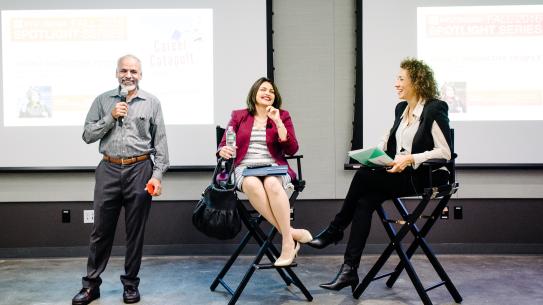
Unnikrishna Pillai, currently Full-Professor ( since 1995) of Electrical Engineering at the Tandon School of Engineering, New York University, joined the Polytechnic Institute of New York (Brooklyn Poly) in 1985 as an Assistant professor. He graduated from the Moore School of Electrical Engineering, University of Pennsylvania with a PhD in Systems Engineering (1985), and prior to that from IIT, Kanpur, India with an MS in Electrical Engineering (1982). He has served as the Electrical Engineering department head for one year in the past (1998-1989) during the Polytechnic years. His research interests include system identification, radar signal processing, synthetic aperture radar (SAR) imaging and identifying moving targets from such radar images and from superfast airborne platforms, machine learning technuiques for signal detection and identification in congested and other environments. His other interests include autonomous navigation of ground and airborne moving vehicles as a swarm (driverless cars driving together, moving drones from 'Here To There' etc.) and risk reduction for portfolios through cognitive methods where greed/risk are managed for moderate returns (profit) with long term goals in mind.
Pillai considers his greatest fortune to be to have had the opportunity to work with Prof. Dante C. Youla of Polytechnic, for over 30 years, an expert on a variety of areas spanning more or less all of Electrical Engineering. Prof. Youla is a remarkable teacher, best mind in any group and working with Prof. Youla has been the highlight of Pillai's technical career and a rewarding 'Zen-like' experience for him in many ways (real highlight of his life being Priya, his daughter!).
He has coauthored five textbooks/monographs related to electrical engineering and four other e-books. For the classroom, he has produced over two hundred and fifty video lectures on YouTube on selected topics to complement his 'so-so' class room lectures so that students have access to more material and examples.
Unni has also published (Guest editor and producer) two translations of "Bhagavad Gita" into Malayalam in one book format with an introduction by him hoping to spread Bhagavan's (God's) words - atleast the interesting ones - among the moderately literate ... He has also sponsored and produced a music CD containing selected Indian mythology excerpts from classic Kathakali plays performed by some of his favorite artists from Kerala (southwest bottom corner of India), none of that music will make hardly any sense to an outsider.
Education
Institute of Technology, BHU, Varanasi, India 1977
Bachelor of Technology (B Tech), Electronics and Telecommunications Engineering
Indian Institute of Technology (IIT), Kanpur, India 1982
Master of Technology (MTech), Electrical Engineering: Digital Communications/Signal Processing
Moore School of Engineering, University of Pennsylvania 1985
Doctor of Philosophy (PhD), Systems Engineering: "Array Signal Processing and Spectrum Estimation
Experience
Bharat Electronics Limited (BEL),
Deputy Engineer (Radar)
Entry level Radar Engineer. Designing and testing of alpha numeric display terminals.
From: January 1978 to July 1980
Polytechnic Institute of New York
Assistant Professor (Sept. 1985 - Aug.1989)
Teaching and Research on Array Signal Processing. Working with Prof. Youla.
From: September 1985 to August 1989
Polytechnic University, New York
Associate Professor (Sept. 1989 - Aug. 1995)
Teaching and research on System Identification, Spectrum Estimation. Working with Prof. Youla.
From: September 1989 to August 1995
Polytechnic University, New York
Department Head (Sept. 1998 - July 1999)
"Cleaned up" some of the inefficient practices within the Dept. Helped the Dean hire the next department head.
From: September 1998 to July 1999
School of Engineering, New York University
Professor ( Sept. 1995 - Present)
On half-time leave-of-absence since September 2010 and on a permanent basis since September 2015. Teaching (probability Theory, Stochastic Processes, Detection, Estimation and Machine Learning) and Research (Radar Signal Processing, Synthetic Aperture Radar Imaging, Blind Signal Estimation, Spectrum Estimation, System Identification).
From: September 1995 to present
Publications
Journal Articles
Around 30 Journal papers; Around 125+ Conference papers; Five books; Two e-books on Amazon Kindle
See http://eeweb.poly.edu/~pillai/
Authored/Edited Books
BOOKS AUTHORED/CO-AUTHORED:
1. Array Signal Processing (1989)
2. Spectrum Esimation and System Identification (1993)
3. Prof. Papoulis' "Probability, Random Variables, and Stochastic Processes" (2002). Translated into Greek, Chinese.
http://www.mhhe.com/engcs/electrical/papoulis/
4. Space Based Radar (2008)
5. Wavefrom Diversity (2011)
Other Publications
1. "Short Videos" on Probability and Stochastic Processes at:
https://www.youtube.com/channel/UC3l1RPdC7259bQZ8JWQYdrw/videos
2. Over 600 slides of Lecture Notes on "Probability and Stochastic Processes" at:
http://www.mhhe.com/engcs/electrical/papoulis/sppts.mhtml
3. "Engineering Probabilty", (2012) on Amazon Kindle
4. "401(k) and the Curse of Volatility", (2012) on Amazon Kindle.
https://www.amazon.com/gp/aw/sitb/B009Q5UWSK?ref=sib_dp_aw_kd_udp
Awards
- All India Rank: 438, Joint Entrance Examination for UG admission to Indian Institue of Technologies (IITs)
- Fellow, IEEE
Patents
Method and apparatus for dynamic swarming of airborne drones for , (US 9104201 B1)
A method, system and apparatus to detect when one or more airborne unmanned aerial vehicles (drones) are close to each other, and to take necessary actions to maintain a minimum distance between drones as well as a maximum distance among the drones in a dynamic environment by automatic navigation. A computer method and apparatus for holding a group of drones in a swarm formation by maintaining the group centroid of the group of drones within a tolerance of a predetermined location is also disclosed. Additionally, methods to move a swarm of drones along a predetermined path while maintaining the swarm formation of the drones is also disclosed.
Method and apparatus for automobile accident reduction using loca, (US 9187118 B2)
A method, system, and apparatus to detect when one or more moving vehicles are close to a first vehicle, and to take necessary actions to maintain a minimum distance between vehicles in a dynamic environment by automatic navigation. A computer method and apparatus for automobile accident reduction by maintaining a minimum distance with respect to all nearby vehicles on the road. In addition, methods to synchronously move a group of vehicles on a highway through a swarming action where each vehicle keeps a region immediately around it free of other vehicles while maintaining the speed of the vehicle immediately in front or nearby is also disclosed.


